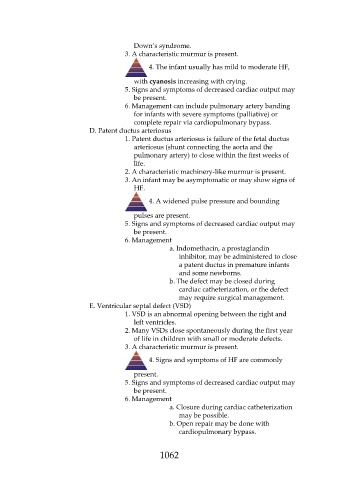Page 1062 - Saunders Comprehensive Review For NCLEX-RN
P. 1062
Down’s syndrome.
3. A characteristic murmur is present.
4. The infant usually has mild to moderate HF,
with cyanosis increasing with crying.
5. Signs and symptoms of decreased cardiac output may
be present.
6. Management can include pulmonary artery banding
for infants with severe symptoms (palliative) or
complete repair via cardiopulmonary bypass.
D. Patent ductus arteriosus
1. Patent ductus arteriosus is failure of the fetal ductus
arteriosus (shunt connecting the aorta and the
pulmonary artery) to close within the first weeks of
life.
2. A characteristic machinery-like murmur is present.
3. An infant may be asymptomatic or may show signs of
HF.
4. A widened pulse pressure and bounding
pulses are present.
5. Signs and symptoms of decreased cardiac output may
be present.
6. Management
a. Indomethacin, a prostaglandin
inhibitor, may be administered to close
a patent ductus in premature infants
and some newborns.
b. The defect may be closed during
cardiac catheterization, or the defect
may require surgical management.
E. Ventricular septal defect (VSD)
1. VSD is an abnormal opening between the right and
left ventricles.
2. Many VSDs close spontaneously during the first year
of life in children with small or moderate defects.
3. A characteristic murmur is present.
4. Signs and symptoms of HF are commonly
present.
5. Signs and symptoms of decreased cardiac output may
be present.
6. Management
a. Closure during cardiac catheterization
may be possible.
b. Open repair may be done with
cardiopulmonary bypass.
1062

